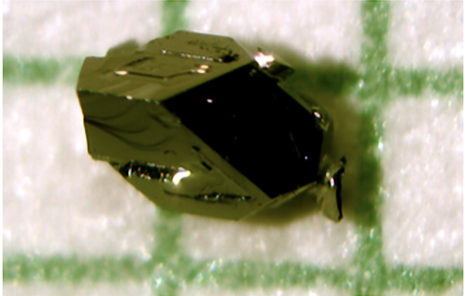Reviewed by Lexie CornerMar 14 2024
Ames National Laboratory scientists have discovered the first unconventional superconductor, with a chemical makeup that is also present in nature
 Image of a miassite crystal grown by Paul Canfield. Image Credit: Ames National Laboratory.
Image of a miassite crystal grown by Paul Canfield. Image Credit: Ames National Laboratory.
Miassite is one of the four naturally occurring minerals that exhibit superconductivity when cultured in a lab. The team's study of miassite unveiled its status as an unconventional superconductor, exhibiting properties akin to those found in high-temperature superconductors.
These findings deepen scientists' comprehension of this form of superconductivity, holding potential for the development of more sustainable and cost-effective superconductor-based technologies in the future.
The ability of a material to conduct electricity without losing energy is known as superconductivity. Applications for superconductors include quantum computers, power cables, and medical MRI machines. Although their critical temperatures are low, conventional superconductors are well understood. The greatest temperature at which a substance exhibits superconductivity is known as the critical temperature.
Unconventional superconductors were discovered in the 1980s, many of which have critical temperatures much higher than others. All of these materials are grown in the lab, according to Ames Lab scientist Ruslan Prozorov. Due to this fact, the general consensus is that unconventional superconductivity is not a product of nature.
According to Prozorov, the majority of superconducting elements and compounds are metals that have a propensity to react with other elements, such as oxygen, making it difficult to find superconductors in nature. One of the many intriguing things about miassite (Rh17S15), is the intricate chemical formula according to Prozorov.
Intuitively, you think that this is something which is produced deliberately during a focused search, and it cannot possibly exist in nature. But it turns out it does.
Ruslan Prozorov, Scientist, Ames National Laboratory
Paul Canfield, an expert in the design, discovery, growth, and characterization of novel crystalline materials, is a Scientist at Ames Lab and a Distinguished Professor of Physics and Astronomy at Iowa State University. For this project, Paul Canfield synthesized premium miassite crystals.
Although miassite is a mineral that was discovered near the Miass River in Chelyabinsk Oblast, Russia. It is a rare one that generally does not grow as well-formed crystals.
Paul Canfield, Scientist, Ames National Laboratory
The process of growing the miassite crystals was part of a more extensive search for compounds that combine volatile elements (like S) and very high melting elements (like Rh).
Contrary to the nature of the pure elements, we have been mastering the use of mixtures of these elements that allow for low temperature growth of crystals with minimal vapor pressure. It’s like finding a hidden fishing hole that is full of big fat fish. In the Rh-S system, we discovered three new superconductors. And, through Ruslan’s detailed measurements, we discovered that the miassite is an unconventional superconductor.
Paul Canfield, Scientist, Ames National Laboratory
Prozorov’s team focuses on cutting-edge methods for researching superconductors at low temperatures. According to Prozorov, the substance had to be as cold as -460 ℉, or 50 millikelvins.
Prozorov’s group employed three distinct tests to identify the type of superconductivity present in miassite. “London penetration depth” is the name of the primary test. It establishes the maximum depth to which a weak magnetic field can reach inside the superconductor bulk from the outside.
At low temperatures, this length in a conventional superconductor is essentially constant. On the other hand, it changes in a temperature-dependent manner in unconventional superconductors. This experiment demonstrated the unusual superconductor behavior of miassite.
The team also tried adding flaws to the material as another test. Prozorov claimed that his team had used this test as a signature method for ten years. The material is subjected to a high-energy electron bombardment. Defects in the crystal structure are created when this process knocks out ions from their positions. The material’s critical temperature may fluctuate as a result of this disorder.
This test would reveal no or very little change in the critical temperature because conventional superconductors are not sensitive to non-magnetic disorders. The critical temperature of unconventional superconductors is suppressed or changes when defects are introduced due to their high sensitivity to disorder. The material's critical magnetic field is also impacted. The researchers discovered that the critical temperature and critical magnetic field in miassite exhibited the expected behavior in nonconventional superconductors.
Their research enhances scientists’ comprehension of the operation of unconventional superconductors. Prozorov explained that this is important because “Uncovering the mechanisms behind unconventional superconductivity is key to economically sound applications of superconductors.”
The study was funded by the DOE Office of Science (Office of Basic Energy Sciences) and utilized resources from the Advanced Photon Source, a US Department of Energy (DOE) Office of Science User Facility.
Journal Reference:
Kim, H., et al. (2024) Nodal superconductivity in miassite Rh17S15. Communications Materials. doi.org/10.1038/s43246-024-00456-w